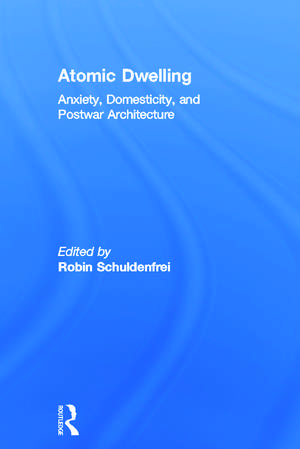Atomic Dwelling: Anxiety, Domesticity, and Postwar Architecture
Editat de Robin Schuldenfreien Limba Engleză Hardback – 16 ian 2012
This collection contains essays that examine the material of art, objects, and spaces in the context of practices of dwelling over the long span of the postwar period. It asks what role material objects, interior spaces, and architecture played in quelling or fanning the anxieties of modernism’s ordinary denizens, and how this role informs their legacy today.
Preț: 853.07 lei
Preț vechi: 1218.96 lei
-30% Nou
Puncte Express: 1280
Preț estimativ în valută:
163.29€ • 177.43$ • 137.25£
163.29€ • 177.43$ • 137.25£
Carte tipărită la comandă
Livrare economică 21 aprilie-05 mai
Preluare comenzi: 021 569.72.76
Specificații
ISBN-13: 9780415676083
ISBN-10: 0415676088
Pagini: 316
Ilustrații: 108 halftones
Dimensiuni: 156 x 234 mm
Greutate: 0.75 kg
Ediția:1
Editura: Taylor & Francis
Colecția Routledge
Locul publicării:Oxford, United Kingdom
ISBN-10: 0415676088
Pagini: 316
Ilustrații: 108 halftones
Dimensiuni: 156 x 234 mm
Greutate: 0.75 kg
Ediția:1
Editura: Taylor & Francis
Colecția Routledge
Locul publicării:Oxford, United Kingdom
Public țintă
PostgraduateCuprins
Introduction Part 1: Psychological Constructions: Anxiety of Isolation and Exposure 1. Taking Comfort in the Age of Anxiety: Eero Saarinen’s Womb Chair 2. The Future is Possibly Past: The Anxious Spaces of Gaetano Pesce 3. Scopophobia/Scopophilia: Electric Light and the Anxiety of the Gaze in American Postwar Domestic Architecture Part 2: Ideological Objects: Design and Representation 4. The Allegory of the Socialist Lifestyle: The Czechoslovak Pavilion at the Brussels Expo, its Gold Medal and the Politburo 5. Assimilating Unease: Moholy-Nagy and the Wartime-Postwar Bauhaus in Chicago 6. The Anxieties of Autonomy: Peter Eisenman from Cambridge to House VI Part 3: Societies of Consumers: Materialist Ideologies and Postwar Goods 7. "But a home is not a laboratory": The Anxieties of Designing for the Socialist Home in the German Democratic Republic 1950—1965 8. Architect-designed Interiors for a Culturally Progressive Upper-Middle Class: The Implicit Political Presence of Knoll International in Belgium 9. Domestic Environment: Italian Neo-Avant-Garde Design and the Politics of Post-Materialism Part 4: Class Concerns and Conflict: Dwelling and Politics 10. Dirt and Disorder: Taste and Anxiety in the Homes of the British Working Class 11. Upper West Side Stories: Race, Liberalism, and Narratives of Urban Renewal in Postwar New York 12. Pawns or Prophets? Postwar Architects and Utopian Designs for Southern Italy. Coda: From Homelessness to Homelessness
Notă biografică
Robin Schuldenfrei is Junior Professor of Art History at Humboldt-Universität zu Berlin.
Recenzii
"Describing a vast spectrum in terms of material scale, from Knoll’s furniture pieces to the new neighbourhoods of Apulia, as well as in terms of time, from the Second World War to the early 1970s, this collection of well-carved essays unveils an intriguing choreography of ideologies and form. Between social engineering and mass marketing, four decades of tensions are discussed in a book that fills numerous gaps in the main narrative scanning architecture and design during the Cold War."
Jean-Louis Cohen, Institute of Fine Art, New York University
"Atomic Dwelling investigates a problem posed by modernism's cold war apogee: that of habitation in an era that offered rising affluence and potential nuclear annihilation. Its incisive essays assemble an innovative and unsettling vista of modernist practice and pedagogy in an age of anxiety."
Greg Castillo, University of California, Berkeley
Jean-Louis Cohen, Institute of Fine Art, New York University
"Atomic Dwelling investigates a problem posed by modernism's cold war apogee: that of habitation in an era that offered rising affluence and potential nuclear annihilation. Its incisive essays assemble an innovative and unsettling vista of modernist practice and pedagogy in an age of anxiety."
Greg Castillo, University of California, Berkeley
Descriere
International scholars from architecture, design, urban planning, and interior design here reappraise modern life in the context of practices of dwelling over the span of the postwar period. Reassessing culture and the economic and political effects on civilian life, this collection looks at what role material objects, interior spaces, and architecture played in quelling or fanning the anxieties of modernism’s ordinary denizens.
